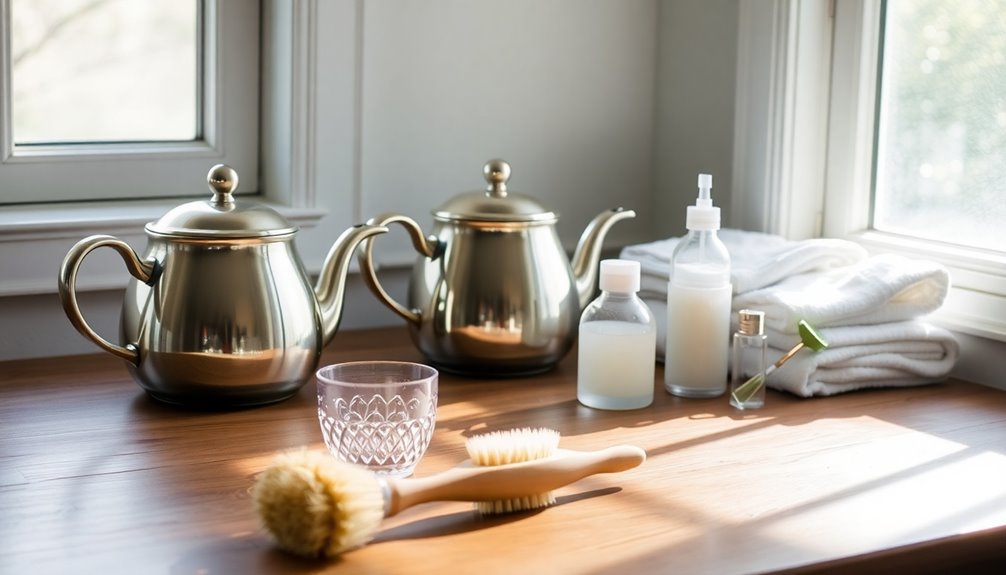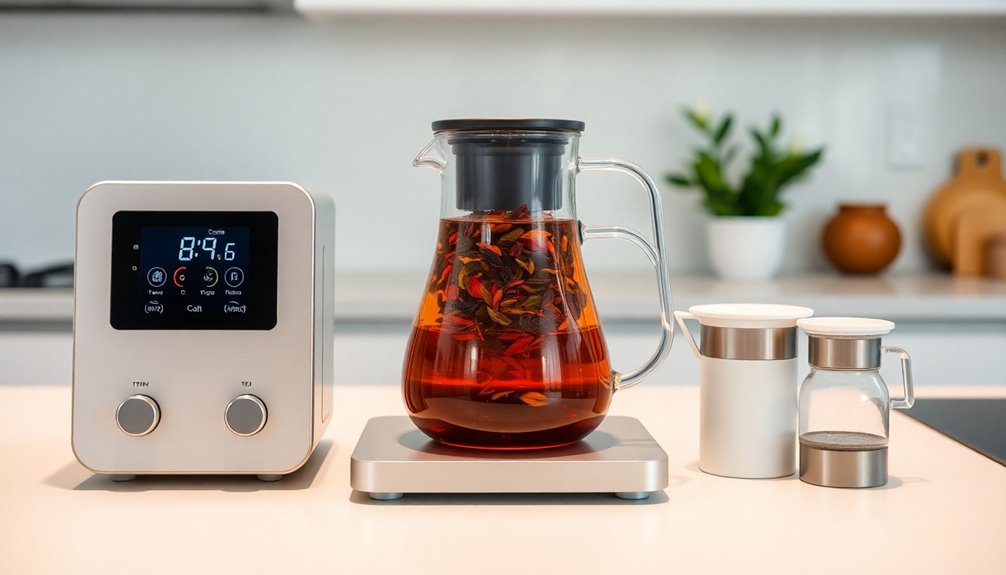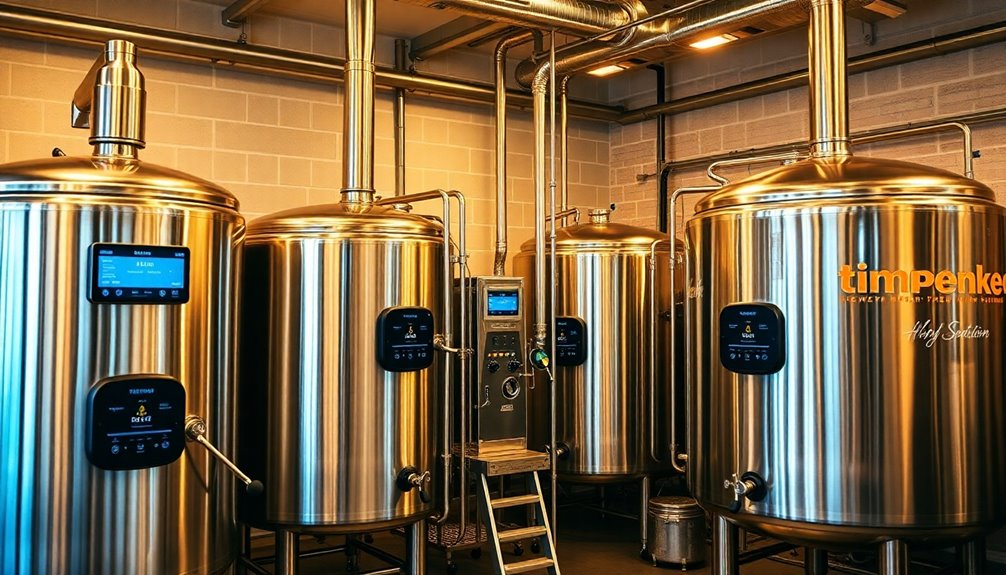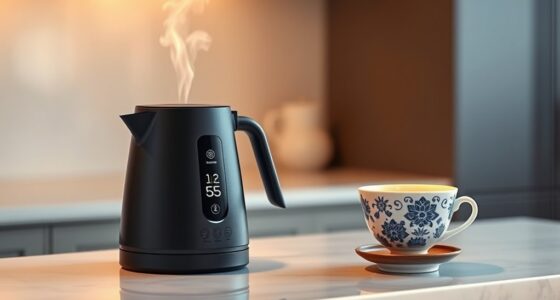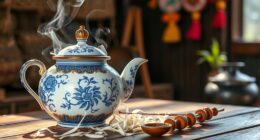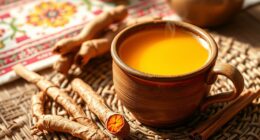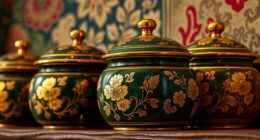Maintaining your tea brewing tools like a pro is super fun and easy! Always rinse your teapot with hot water after each use, and skip the soap—it helps keep the flavors intact. For kettles, use equal parts water and white vinegar to tackle pesky limescale every couple of months. Don't forget to dry things with a soft cloth to keep them shining! If your infuser or teapot has stubborn stains, a little baking soda or lemon juice can work wonders. Keeping your tools clean makes your tea taste amazing, and there's even more cool stuff to learn about tea care!
Key Takeaways
- Rinse all tea brewing tools with hot water after each use to prevent residue buildup and maintain flavor integrity.
- Avoid using soap on clay and cast iron teapots; instead, preheat with hot water for optimal steeping.
- Regularly descale kettles every 1 to 3 months using equal parts water and white vinegar to remove limescale buildup.
- Clean metal and ceramic tools with a baking soda paste for stubborn stains; use vinegar for glass and ceramic.
- Store teapots in a cool, dry place and avoid stacking to prevent scratches and maintain their appearance.
Introduction

Maintaining your tea brewing tools is essential for enjoying the perfect cup of tea. Just imagine sipping a warm, fragrant cup that tastes exactly how you want it! To make that dream come true, you need to keep your brewing tools clean and ready for action.
After each use, don't forget to give your infusers a good rinse. This step is super important, especially for metal and plastic ones, as they can soak up odors and oils, hiding your tea's true flavor.
For clay and cast iron teapots, hot water is your best friend—stay away from soap to keep their natural charm intact. If you have glass or ceramic infusers, a quick rinse should do the trick, but for those pesky stains, a little soak in a vinegar solution works wonders!
Make sure to dry your tools with a soft cloth to avoid water spots. Store your tea brewing tools in a cool, dry place, and if you've got a clay teapot, leave the lid slightly open to keep it fresh and mold-free.
With these simple cleaning tips, you're all set for delightful tea brewing adventures!
Essential Care for Teapots

To enjoy the full potential of your teapot, you need to give it the care it deserves. After each tea session, rinse your teapot with hot water right away. This simple step prevents residue buildup, keeping the flavors fresh and delightful. Remember, skip the soap! It can mess with future brews. Additionally, using fresh, filtered water can enhance the taste of your tea and will help preserve the antioxidants present in herbal teas.
Before brewing, preheat your teapot by swirling some hot water inside. This helps maintain the perfect temperature for steeping, allowing your tea to shine.
When it comes to storage, keep your teapot in a cool, dry place. Avoid stacking it with other dishes—nobody wants scratches on that beautiful surface! It's also important to note that regularly checking for freshness can make a significant difference in your tea experience.
If you have a clay teapot, leave the lid slightly open while it's stored. This little trick allows air to circulate and keeps mold at bay.
For stubborn stains, soak your teapot in a vinegar or baking soda solution. After a gentle scrub, rinse it thoroughly to keep it looking sharp and free from odors. Additionally, using proper storage techniques can further enhance the longevity of your teapot.
With these easy cleaning tips, your teapot will be ready for many delicious brews ahead. So, get ready to make some tasty tea!
Regular Descaling for Kettles
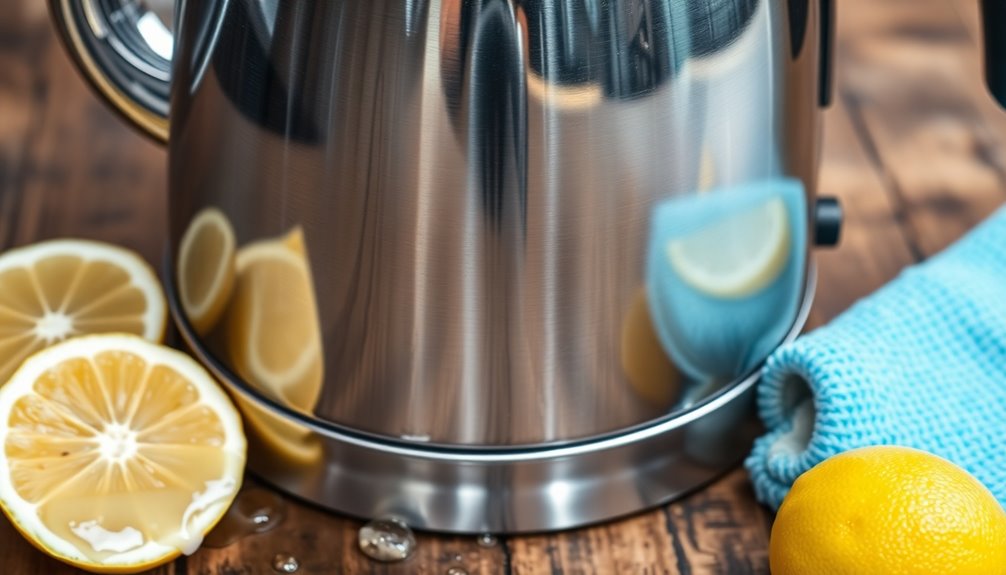
Regular descaling of your kettle is essential for preserving its performance and ensuring the best taste in your tea.
If you live in an area with hard water, limescale can build up in your kettle, making it less efficient at heating water. This means your tea mightn't taste as good as it should! To tackle this, you can use a descaling solution or even a mixture of equal parts water and white vinegar. Both work wonders at dissolving those pesky limescale deposits.
For the best results, make sure to descale your kettle every 1 to 3 months, depending on how hard your water is and how often you use your kettle.
Once you're done, don't forget to rinse your kettle thoroughly with clean water to wash away any leftover solution or vinegar. This step is crucial to keep your kettle and your tea tasting fresh!
Lastly, always check your kettle's manufacturer instructions for any specific descaling recommendations—they know their product best!
With a little regular care, your kettle will continue to brew delicious tea for years to come. Happy brewing!
Eco-Friendly Cleaning Methods

Eco-friendly cleaning methods are a fantastic way to keep your tea brewing tools in top shape while being kind to the environment.
You can start by soaking your tea infusers and teapots in a simple mixture of equal parts vinegar and water. This natural cleaner effectively breaks down stains and mineral buildup without using any harmful chemicals.
For stubborn stains on metal and ceramic tools, try making a paste with baking soda and water. It's a gentle abrasive that won't scratch your surfaces!
If you have glass infusers, lemon juice is your new best friend. Just soak or wipe down the surface to eliminate odors and make your glass shine.
To freshen up your teapot or kettle, boil water with a few slices of lemon. It'll not only remove lingering odors but also mineral deposits, giving you a clean brewing environment.
Lastly, remember to rinse your tea brewing tools with hot water right after using them. This simple step helps prevent residue buildup and keeps your flavors intact, ensuring your equipment lasts longer.
Infuser Material Impact on Flavor

Understanding how the material of your tea infuser impacts flavor is crucial for brewing the perfect cup. Different infuser materials can change how your tea tastes, so it's important to choose wisely!
Metal infusers are super durable, but they can react with delicate teas, which might ruin your brew. On the other hand, glass and ceramic infusers are great because they don't affect the flavor at all and are easy to clean.
Now, if you love whole leaf teas, basket infusers are your best friend! They're deeper and help the tea leaves expand, allowing for better flavor extraction.
Just be careful with traditional ball infusers, as they can be a little too tight for those lovely leaves. While plastic infusers might look pretty, they can soak up flavors and even leach toxins, so make sure to buy high-quality ones!
Cleaning and maintaining your infuser is key, especially for metal and plastic options. If you don't keep them clean, old tea residue can make your next cup taste funny!
Practical Applications
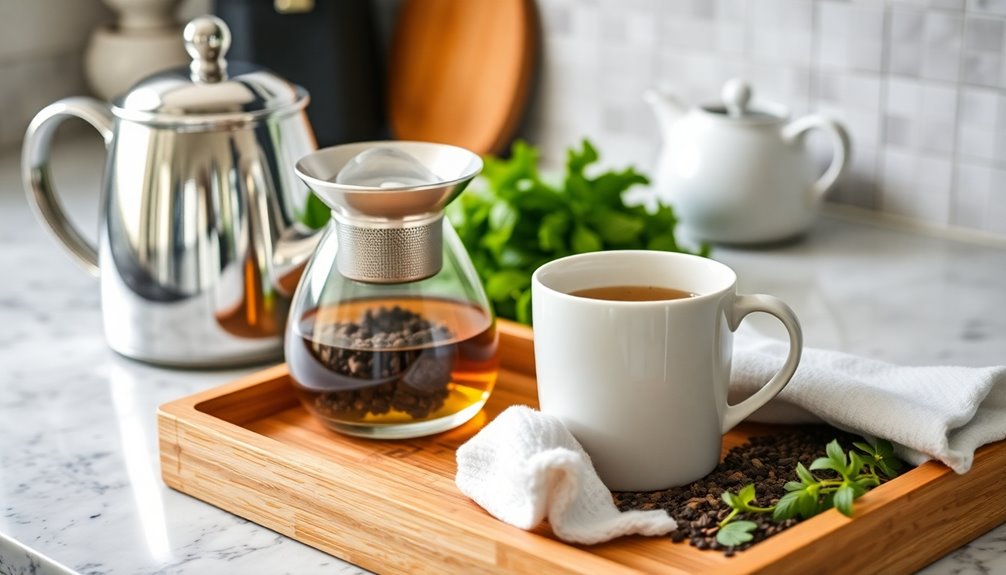
Maintaining your tea brewing tools not only enhances your tea experience but also prolongs the life of your equipment. After each use, remember to rinse your ceramic teapot with hot water—no soap! This keeps those delightful flavors intact and prevents any yucky contamination.
For your metal tea infuser, a quick soak in a vinegar solution works wonders to banish stains and odors. Just make sure you rinse it really well afterward to keep the taste just right for your next brewing process.
When it comes to storage, place your ceramic and glass teapots in a cool, dry place. Avoid stacking them with other items to dodge scratches and damage—no one wants a sad teapot!
After washing, dry your teapots and infusers with a soft cloth, steering clear of heat sources or they might crack or warp.
Lastly, check your tools occasionally for cracks or damage; these can mess with your brewing and could even be unsafe. If you spot any issues, fix or replace them quickly. Additionally, consider using air purifiers to improve your overall brewing environment, as they can reduce allergens that may affect your tea experience.
Frequently Asked Questions
How Do Professionals Make Tea?
Professionals make tea by selecting high-quality leaves, measuring them precisely, and controlling water temperature. They steep according to tea type, ensuring optimal flavor extraction while using clean tools for best results. Enjoy the process!
What Is the Gongfu Method?
The Gongfu method's all about maximizing flavor. You use small teapots, high tea-to-water ratios, and short steeping times. It's a social experience, where you savor the evolving flavors through multiple infusions. Enjoy each sip!
How Do You Make Tea Like a Pro?
To make tea like a pro, use filtered water, preheat your teapot, measure tea accurately, steep at the right temperature, and experiment with flavors. This will elevate your tea experience and impress your guests.
How to Make Tea Bags Stronger?
To make your tea bags stronger, use two bags per cup, steep for the recommended time, and ensure you're using freshly boiled water at the right temperature. Experiment with loose leaf for even better flavor!
Conclusion
Now that you know how to care for your tea brewing tools, you can enjoy your favorite brews even more! Keeping your teapots, kettles, and infusers clean not only makes them last longer but also helps your tea taste its best. Remember, a little love and attention go a long way in the tea world. So, grab your supplies, put on your cleaning cape, and let's keep that tea adventure going strong! Happy brewing!

